Cybermodeler Online
Celebrating 24 years of hobby news and reviews
PROUDLY SPONSORED BY:

The appearance of U.S. Air Force, U.S. Army, U.S. Navy, U.S. Marine Corps, U.S. Coast Guard, Department of Defense, or NASA imagery or art does not constitute an endorsement nor is Cybermodeler Online affiliated with these organizations.


Hasegawa 1/48 Voyager Space Probe Build Review
By chuck holte.
Two Voyager Space Probes were launched in 1977 to document their "Grand Tour" of our solar system and beyond. The 1,600 pound Voyager payload, built by the Jet Propulsion Laboratory in California, was launched on 5 Sep 77 from Cape Canaveral, Florida atop a Titan-Centaur booster. Voyager, traveling at up to 38,000 miles per hour, completed is assigned mission in our solar system and is now racing into interstellar space. Several of the onboard mission systems are still collecting data and sending it back to earth. The "energizer bunny" of space probes is now more than 11.6 billion miles from earth and has traveled deeper into space than any other man-made object.
Build Review
The editor's first look at this kit can be found here .
I typically model in smaller scales, but couldn't resist building one of the most unique and fascinating space probes of our time, even if it had to be in 1/48 scale. I found the kit to be well engineered, accurate and relatively easy to assemble. The black and white, eight page, 12 step instructions are in English and Kanji and identify the various mission systems by name. Two of the 12 pages contain nice six-view drawings of the spacecraft with painting instructions. Decals were not included (or needed).
I mostly followed the recommended modular instruction process. Several aftermarket manufacturers offer PE sets to replace some of the more intricate, but solid molded parts, such as the instrument boom and the long magnetometer boom. I elected to use the Eduard PE set # 48761 , which I think made a significant improvement in the appearance of the finished model.
I painted most everything as I completed the modules called out on the instruction sheet using mostly rattle can Tamiya paints: Fine Surface Primer (White), Semi-Gloss Black (TS-29) and Mica Silver (TS-76). Final assembly proceeded according to the instruction plan with the delicate PE boom and mast saved for the last steps. I used small diameter brass rods to replace the kit's long wire antenna parts.

This was an interesting and enjoyable build. I didn't find any problems with the kit as provided, but I think the aftermarket PE sets really make a difference in the final appearance of the model. Highly recommended for real-space model fans.

Copyright © 2024 TacAir Publications, LLC.

- Jeux et Jouets
- Maquettes et modélisme
- Répliques miniatures
- Modèles à l'échelle

Essai gratuit Prime
Bénéficiez d'une livraison premium pour cette commande avec Amazon Prime, gratuitement pendant 30 jours. «Livraison Prioritaire» Annulez à tout moment.
- La livraison en 1 jour ouvré gratuite et illimitée sur des millions d'articles
- Un accès prioritaire aux Ventes Flash éligibles 30 minutes avant leur démarrage officiel
- Films et séries dont les séries Amazon Original en streaming immédiat sur PrimeVideo.com ou sur tous vos écrans avec l'application Prime Video
Important : Votre carte de crédit ne sera pas débitée lorsque vous commencerez votre essai gratuit ou si vous annulez pendant la période d'essai. Si vous êtes satisfait de Prime, ne faites rien. A l'issue de la période d'essai, le programme Prime est facturé EUR 69.90 par an pour une inscription annuelle ou EUR 6.99 par mois pour une inscription mensuelle.
Amazon Global Store
- Les produits internationaux ont des conditions de vente distinctes, sont vendus depuis l'étranger et peuvent différer des produits locaux, y compris la taille, la classe d'âge, et la langue du produit, de l'étiquetage ou des notices.
- En savoir plus sur Amazon Global Store.

Image indisponible

- Pour voir cette vidéo, téléchargez Flash Player
Hasegawa Unmanned Space Probe Voyager (Plastic model)
Options d'achat et paniers plus, à propos de cet article.
- Kit de modélisme
- Peut nécessiter des peintures et des colles pour l'assemblage
- Modèle à échelle précise
- Instructions détaillées fournies (français non )
- Décalcomanies/transferts inclus
Produits fréquemment achetés ensemble

Les articles du moment que vous pourriez aimer

Informations sur le produit
Descriptif technique, informations complémentaires, politique de retour, description du produit, recherchez-vous des informations spécifiques , commentaires client.
Les avis clients, y compris le nombre d’étoiles du produit, aident les clients à en savoir plus sur le produit et à décider s'il leur convient.
Pour calculer le nombre global d’étoiles et la ventilation en pourcentage par étoile, nous n'utilisons pas une simple moyenne. Au lieu de cela, notre système prend en compte des éléments tels que la date récente d'un commentaire et si l'auteur de l'avis a acheté l'article sur Amazon. Les avis sont également analysés pour vérifier leur fiabilité.
Commentaires avec images

- Classer les commentaires par Meilleures évaluations Le plus récent Meilleures évaluations
Meilleures évaluations de France
Un problème s'est produit lors du filtrage des commentaires. veuillez réessayer ultérieurement..
Meilleurs commentaires provenant d’autres pays
Sécurité du produit
Attention:Ne convient pas aux enfants de moins de 14 ans. À utiliser sous la surveillance d'un adulte
Détails de conformité du produit
Consulter les détails de conformité de ce produit ( Personne responsable dans l’UE ).
- À propos d'Amazon
- Amazon Science
- Vendez sur Amazon
- Vendez sur Amazon Business
- Vendez sur Amazon Handmade
- Protégez et développez votre marque
- Devenez Partenaire
- Expédié par Amazon
- Faites la promotion de vos produits
- Auto-publiez votre livre
- › Voir plus : Gagner de l'argent avec nous
- Carte Amazon Business Amex
- Cartes de paiement
- Paiement en plusieurs fois
- Convertisseur de devises Amazon
- Cartes cadeaux
- Recharge en ligne
- Recharge en point de vente
- Voir ou suivre vos commandes
- Tarifs et options de livraison
- Amazon Prime
- Retours et remplacements
- Rappels et alertes de sécurité des produits
- Recyclage (y compris les équipements électriques et électroniques)
- Infos sur notre Marketplace
- Application Amazon Mobile
- Service Client
- Accessibilité
- Royaume-Uni
- Émirats arabes unis
- Conditions générales de vente
- Vos informations personnelles
- Annonces basées sur vos centres d’intérêt

Résultats par : Messages Sujets
Vous n'êtes pas connecté. Connectez-vous ou enregistrez-vous
Maquette de la sonde Voyager d'Hasegawa au 1/48ème
1 maquette de la sonde voyager d'hasegawa au 1/48ème dim 9 mai 2021 - 20:39.
2 Re: Maquette de la sonde Voyager d'Hasegawa au 1/48ème Lun 10 Mai 2021 - 9:56
3 re: maquette de la sonde voyager d'hasegawa au 1/48ème mer 12 mai 2021 - 21:12.

4 Re: Maquette de la sonde Voyager d'Hasegawa au 1/48ème Sam 22 Mai 2021 - 15:30
5 Re: Maquette de la sonde Voyager d'Hasegawa au 1/48ème Lun 24 Mai 2021 - 10:30
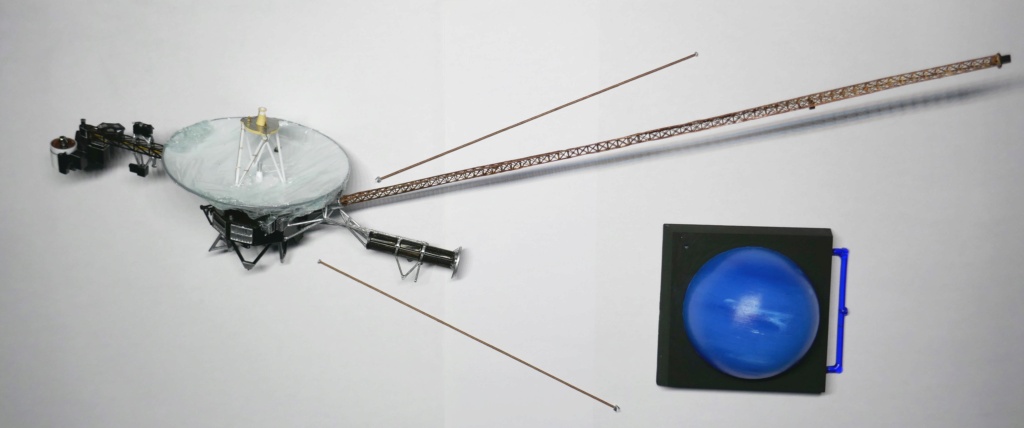
faybirdy aime ce message
6 Re: Maquette de la sonde Voyager d'Hasegawa au 1/48ème Sam 29 Mai 2021 - 15:57

7 Re: Maquette de la sonde Voyager d'Hasegawa au 1/48ème Lun 31 Mai 2021 - 16:23

8 Re: Maquette de la sonde Voyager d'Hasegawa au 1/48ème Dim 20 Juin 2021 - 20:06
9 Re: Maquette de la sonde Voyager d'Hasegawa au 1/48ème Lun 21 Juin 2021 - 15:25

Dernière édition par Apollo68 le Lun 21 Juin 2021 - 21:14, édité 1 fois
10 Re: Maquette de la sonde Voyager d'Hasegawa au 1/48ème Lun 21 Juin 2021 - 18:54
11 re: maquette de la sonde voyager d'hasegawa au 1/48ème lun 21 juin 2021 - 21:05.
Dernière édition par Apollo68 le Lun 21 Juin 2021 - 21:13, édité 1 fois
12 Re: Maquette de la sonde Voyager d'Hasegawa au 1/48ème Sam 24 Juil 2021 - 21:36
13 re: maquette de la sonde voyager d'hasegawa au 1/48ème dim 25 juil 2021 - 21:57.
Spacedream aime ce message
14 Re: Maquette de la sonde Voyager d'Hasegawa au 1/48ème Lun 26 Juil 2021 - 21:13
15 re: maquette de la sonde voyager d'hasegawa au 1/48ème mer 10 nov 2021 - 17:56, phyl d'ariane.
16 Re: Maquette de la sonde Voyager d'Hasegawa au 1/48ème Sam 13 Nov 2021 - 17:16
phyl d'ariane a écrit: sacrée maquette et bravo pour ta travail de réalisme ces sondes ont été les parents pauvres du modélisme depuis 50 ans, c'est bien dommage pour les amateurs
17 Re: Maquette de la sonde Voyager d'Hasegawa au 1/48ème
Contenu sponsorisé.
MAQUETTES SPATIALES » ESPACE AMERICAIN » AUTRES » Maquette de la sonde Voyager d'Hasegawa au 1/48ème
Sujets similaires
Permission de ce forum: Vous ne pouvez pas répondre aux sujets dans ce forum
Sauter vers:
- Créer un forum | © phpBB | Forum gratuit d'entraide | Signaler un abus | Forumactif.com
RealSpace Models | N° | 1:24

Statistiques
Nasa-national aeronautics and space administration (1958-now), contenu de la boîte.
Photodécoupe, Résine (moulée), Formé par dépression, Métal
Chronologie du produit

Place de marché
Aucun de nos partenaires ou magasins partenaires n'a ceci en vente actuellement.
Avis sur le contenu de la boîte
Examens externes.

Matériel de référence


- Engineering & Transportation
- Transportation
Fulfillment by Amazon (FBA) is a service we offer sellers that lets them store their products in Amazon's fulfillment centers, and we directly pack, ship, and provide customer service for these products. Something we hope you'll especially enjoy: FBA items qualify for FREE Shipping and Amazon Prime.
If you're a seller, Fulfillment by Amazon can help you grow your business. Learn more about the program.

Download the free Kindle app and start reading Kindle books instantly on your smartphone, tablet, or computer - no Kindle device required .
Read instantly on your browser with Kindle for Web.
Using your mobile phone camera - scan the code below and download the Kindle app.

Follow the author

Image Unavailable

- To view this video download Flash Player

NASA Voyager 1 & 2 Owners' Workshop Manual - 1977 onwards (VGR77-1 to VGR77-3, including Pioneer 10 & 11): An insight into the history, technology, ... sent to study the outer planets and beyond Hardcover – August 25, 2015
Voyager 1 has recently crossed the boundary of our solar system and passed into interstellar space, and Voyager 2 is likely to follow suit, on a different path, between 2016 and 2017. The two Voyager probes will continue to transmit details of discoveries beyond our solar system until at least 2020.
- Part of series Owners' Workshop Manual
- Print length 200 pages
- Language English
- Publisher Haynes Publishing UK
- Publication date August 25, 2015
- Dimensions 8.5 x 0.75 x 11 inches
- ISBN-10 0857337750
- ISBN-13 978-0857337757
- See all details

Similar items that may deliver to you quickly

Editorial Reviews
About the author.
Dr. Christopher Riley is a broadcaster and filmmaker specializing in history and science documentaries. In 2004, he won the Sir Arthur Clarke award for the BBC1 blockbuster series Space Odyssey: Voyage to the Planets . His film In the Shadow of the Moon: The Story of the Apollo Astronauts , won the World Cinema Audience Award in 2007.
Product details
- Publisher : Haynes Publishing UK; Illustrated edition (August 25, 2015)
- Language : English
- Hardcover : 200 pages
- ISBN-10 : 0857337750
- ISBN-13 : 978-0857337757
- Item Weight : 1.94 pounds
- Dimensions : 8.5 x 0.75 x 11 inches
- #453 in Astronautics & Space Flight
- #1,196 in Aeronautics & Astronautics (Books)
- #1,853 in Astrophysics & Space Science (Books)
About the author
Christopher riley.
Christopher Riley is a film producer, director and writer specialising in science, engineering and history. His work has been celebrated by BAFTA, the US Television Academy, the Royal Television Society and the Sundance Institute. He holds a doctorate from Imperial College and is a Visiting Professor of Science and Media at the University of Lincoln.
His latest book on the Apollo astronauts' adventures on the Moon - "Where once we stood" is a collaboration with artist Martin Impey. His best selling Apollo 11 owner's workshop manual has also been updated and re-released for the 50th anniversary of the first Moon landing in 2019.
Chris has directed and produced on over one hundred programmes for the BBC - including their flagship science and technology strand 'Tomorrow's World' and the cult science show 'Rough Science'. He was the producer of the BBC's blockbuster drama documentary 'Space Odyssey - Voyage to the Planets', and conceived, produced and directed on the Sundance award-winning feature documentary film 'In the Shadow of the Moon'. He was the producer of the restored director's cut of NASA's original Apollo doc Moonwalk One, released on DVD for the 40th Anniversary of Apollo 11 in 2009. A Blu-ray of the film was released in 2019.
He is the producer and director of the unique Yuri Gagarin 50th Anniversary film project First Orbit; which collaborated with ESA astronaut Paolo Nespoli to film a new view of what Yuri Gagarin would have seen on his pioneering orbit of the Earth in 1961. The film is available on DVD and BluRay from Amazon, subtitled into 30 languages.
During the summer of 2011 he produced a film with Kevin Fong for BBC TWO on the final flight of NASA's Space Shuttle. In 2012 he produced a film about the Voyager missions for BBC FOUR, presented by Dallas Campbell, and directed a major biopic on Neil Armstrong for the BBC. His 2013 films include 'The Fantastic Mr Feynman' - a biography of the nobel prize winning physicist Richard Feynman, broadcast to celebrate what would have been his 95th birthday.
Chris is the author of more than forty articles and books on astronomy and planetary science and regularly lectures on this and other topics. Chris wrote the chapter on Yuri Gagarin's 1961 visit to London in the 2011 British Council book 'Gagarin in Britain' and co-authored a chapter in the 2012 book International Cooperation for Development of Space, from the Aerospace Technology Working Group, a non-profit Space Policy Program Innovation Centre.
His original book for Haynes on Apollo 11 - 'an owner's workshop manual', was published in June 2009 and made it into Amazon's top ten science books of that year. His follow up Haynes manual on the Apollo Lunar Rover came out in 2012.
He is a contributing author to Faber and Faber's 2012 book 'Big Questions from Little People', and their follow up 2013 books 'Does my Goldfish Know who I am?' and 'Why Can't I Tickle Myself'.

Customer reviews
Customer Reviews, including Product Star Ratings help customers to learn more about the product and decide whether it is the right product for them.
To calculate the overall star rating and percentage breakdown by star, we don’t use a simple average. Instead, our system considers things like how recent a review is and if the reviewer bought the item on Amazon. It also analyzed reviews to verify trustworthiness.
- Sort reviews by Top reviews Most recent Top reviews
Top reviews from the United States
There was a problem filtering reviews right now. please try again later..
Top reviews from other countries
- Amazon Newsletter
- About Amazon
- Accessibility
- Sustainability
- Press Center
- Investor Relations
- Amazon Devices
- Amazon Science
- Sell on Amazon
- Sell apps on Amazon
- Supply to Amazon
- Protect & Build Your Brand
- Become an Affiliate
- Become a Delivery Driver
- Start a Package Delivery Business
- Advertise Your Products
- Self-Publish with Us
- Become an Amazon Hub Partner
- › See More Ways to Make Money
- Amazon Visa
- Amazon Store Card
- Amazon Secured Card
- Amazon Business Card
- Shop with Points
- Credit Card Marketplace
- Reload Your Balance
- Amazon Currency Converter
- Your Account
- Your Orders
- Shipping Rates & Policies
- Amazon Prime
- Returns & Replacements
- Manage Your Content and Devices
- Recalls and Product Safety Alerts
- Conditions of Use
- Privacy Notice
- Consumer Health Data Privacy Disclosure
- Your Ads Privacy Choices
To ride, fly, sail, everything is there at MHD!
- SPECIAL OFFERS

Maquette plastique Sonde Spatiale VOYAGER 1:48 SW02
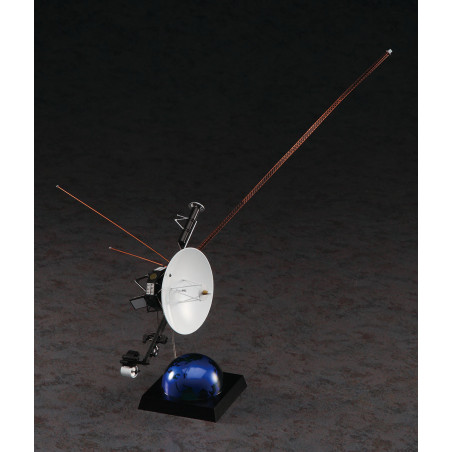
- Article sold out

- Out of production

- Скидки дня
- Справка и помощь
- Адрес доставки Идет загрузка... Ошибка: повторите попытку ОК
- Продажи
- Список отслеживания Развернуть список отслеживаемых товаров Идет загрузка... Войдите в систему , чтобы просмотреть свои сведения о пользователе
- Краткий обзор
- Недавно просмотренные
- Ставки/предложения
- Список отслеживания
- История покупок
- Купить опять
- Объявления о товарах
- Сохраненные запросы поиска
- Сохраненные продавцы
- Сообщения
- Уведомление
- Развернуть корзину Идет загрузка... Произошла ошибка. Чтобы узнать подробнее, посмотрите корзину.
Caractéristiques principales du produit
- Pays de fabrication Japon
- Echelle 1:48
Hasegawa 1:48 Scale Aircraft Aircrafts
Hasegawa 1:48 diecast & toy vehicles, hasegawa militaria 1:48 aircraft airplanes, hasegawa militaria 1:48 aircraft helicopters, hasegawa 1:48 scale toy models & kits, 1/48 aeromaster.
Consulter le journal
- Les Décodeurs
Où sont les sondes « Voyager » lancées il y a quarante ans dans l’espace ?
En 1977, les sondes jumelles quittaient la Terre afin d’explorer le Système solaire extérieur. Elles sont aujourd’hui parmi les objets humains les plus lointains de l’histoire.
Par Gary Dagorn
Temps de Lecture 4 min.
- Ajouter à vos sélections Ajouter à vos sélections
- Partager sur Twitter
- Partager sur Messenger
- Partager sur Facebook
- Envoyer par e-mail
- Partager sur Linkedin
- Copier le lien
Le 31 janvier 1966, pour la première fois de l’histoire, Luna 9, une sonde soviétique, se posait sur la surface d’un autre corps céleste que la Terre : sa voisine, la Lune. Ainsi, nous parvinrent les premières photographies des paysages lunaires. Luna 9 venait d’ouvrir une ère nouvelle : celle de l’exploration du Système solaire par les robots.
Quelques mois après l’exploit soviétique, le rapport d’un ingénieur de la NASA allait poser les bases du plus ambitieux programme de sondes spatiales jamais conçu. En avril 1966, Gary Flandro, qui étudie depuis deux ans les possibilités d’exploration du Système solaire extérieur (c’est-à-dire la partie située après la ceinture d’astéroïdes), publie un article démontrant qu’un rare alignement à venir des planètes gazeuses du Système solaire, entre 1977 et 1979, rend possible leur survol dans des conditions exceptionnellement favorables.
Plus de 10 000 trajectoires étudiées
Cet alignement, qui ne se produit que tous les cent soixante-seize ans, va permettre aux ingénieurs de la NASA de calculer des trajectoires vers Jupiter, Saturne, Uranus et Neptune en utilisant le concept d’assistance gravitationnelle. En survolant les planètes de près, les sondes peuvent utiliser leur gravité comme une fronde pour accélérer et se projeter vers une autre, réduisant le temps et la quantité de carburant nécessaires et rendant accessible des planètes qui ne l’étaient pas jusque-là. Cet alignement permet par exemple de viser un survol de Neptune en une douzaine d’années seulement, là où un tel voyage aurait pris trente ans auparavant.
La NASA décide alors de ne pas laisser passer cette opportunité unique de survoler des planètes encore mal connues. Plus de 10 000 trajectoires seront envisagées par les ingénieurs, avant que deux ne soient retenues pour les deux sondes jumelles.
Aucun autre engin n’a depuis survolé Uranus et Neptune
Lancées les 20 août et 5 septembre 1977, elles survoleront toutes deux Jupiter et Saturne entre 1979 et 1981. La mission de Voyager 2 sera ensuite prolongée jusqu’aux survols d’Uranus en 1986 et de Neptune en 1989, deux planètes photographiées pour la première et la dernière fois à cette occasion. Aucun autre engin n’a depuis survolé les deux géantes gazeuses. Les trajectoires suivies par les deux sondes jumelles furent si précisément calculées que lorsque Voyager 2 survola Neptune en 1989 après un parcours de 7,12 milliards de kilomètres, son point de survol le plus proche fut atteint avec une précision de 100 kilomètres. Ce qui est comparable à réussir à viser un trou au golf à une distance de 3 630 kilomètres.
Au moment où ces lignes sont écrites, Voyager 1 et Voyager 2 se trouvent respectivement à 20,8 milliards et 17,1 milliards de kilomètres de la Terre, et continuent à communiquer avec la Terre quarante ans après leur lancement (alors que leur mission devait durer cinq ans). Des distances considérables que leurs faibles signaux mettent désormais respectivement dix-neuf heures et seize heures à parcourir.
Pour mieux représenter ces grandes distances, voici une représentation miniature du Système solaire où chaque million de kilomètres est ramené à la taille d’un pixel sur votre écran. Il vous faudra faire défiler cette page un certain temps avant d’atteindre les sondes Voyager (1 Gkm = 1 milliard de kilomètres ; la taille des planètes n’est pas à l’échelle).

Les sondes Voyager ont-elles quitté le système solaire ?
Cela dépend de la façon dont on choisit de définir le « Système solaire », c’est-à-dire de déterminer quand s’arrête l’influence du Soleil, et quand commence le milieu interstellaire.
Si l’on définit le Système solaire comme la zone d’influence gravitationnelle du Soleil, c’est-à-dire la zone où la force de gravité exercée par le Soleil reste supérieure à celle des étoiles voisines, alors on estime qu’elle s’étend sur deux années-lumière (soit environ 19 000 milliards de kilomètres). Dans ce cas de figure, les sondes Voyager sont loin, très loin, d’avoir quitté le Système solaire. Pour prendre un point de comparaison, si un tel voyage se résumait à marcher depuis le point zéro des routes de France situé sur le parvis de Notre-Dame de Paris jusqu’à la Grande Arche de la Défense, en quarante ans, Voyager 1 n’aurait parcouru que… 5 mètres.
Si en revanche, on définit le Système solaire comme la zone d’influence magnétique du Soleil, on estime que Voyager 1 a quitté le Système solaire en août 2012 et que Voyager 2, qui évolue depuis quelques années dans ce que l’on appelle l’ « héliogaine » , une zone où le vent solaire (les particules éjectées continuellement par le Soleil) est fortement ralenti par le milieu interstellaire, entrera pleinement dans le milieu interstellaire d’ici à 2020.
La prochaine étoile ? Pas la porte à côté
Après leur sortie définitive du Système solaire, les deux sondes jumelles ne rencontreront pas d’autres astres avant un certain temps. Voyager 1, qui se dirige vers la constellation d’Ophiuchus, passera à environ 1,6 année-lumière de l’étoile Gliese 445 d’ici à 40 000 ans. Cette dernière, actuellement située à 17 années-lumière du Soleil, s’en rapproche à la vitesse astronomique de 120 km/s. Elle passera à ce moment-là à seulement 3,45 années-lumière de notre étoile.
A peu près au même moment, Voyager 2 passera relativement près de Ross 248, une étoile naine de couleur rouge distante de 10,32 années-lumière (c’est-à-dire dans le voisinage du Soleil) qui se rapproche également à grande vitesse de notre étoile. A son point de passage le plus proche, la sonde devrait passer à environ 1,76 année-lumière de cette petite étoile.
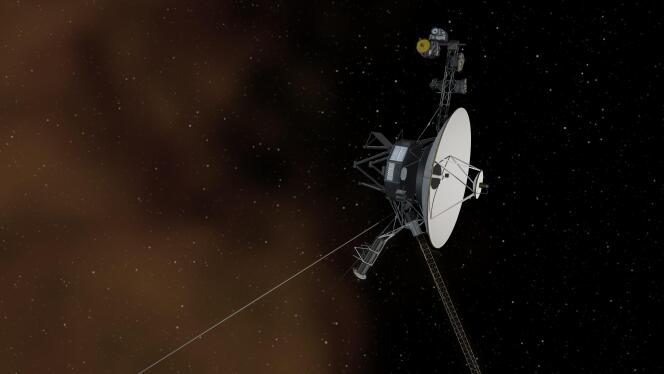
A ce moment-là, les sondes auront cessé depuis très longtemps d’enregistrer des données et d’émettre vers la Terre. Les générateurs électriques à radio-isotope qu’elles embarquent perdent une puissance de 4 watts par an, forçant les ingénieurs à désactiver des systèmes pour rallonger leur durée de vie. A ce rythme, elles ne pourront probablement plus fonctionner au-delà de 2025.
Ne leur restera plus alors que leur rôle d’ambassadrices itinérantes de la Terre, à l’instar des sondes Pioneer 10 & 11 lancées en 1972-1973, qui furent les premiers objets humains destinés à quitter le Système solaire.
> Retrouvez tous les articles explicatifs des Décodeurs
Gary Dagorn
Voir les contributions
Services Le Monde

Cours en ligne, cours du soir, ateliers : développez vos compétences

Testez votre culture générale avec la rédaction du Monde

Mots croisés, sudoku, mots trouvés… Jouez avec nous

Gagnez du temps avec notre sélection des meilleurs produits

Retrouvez nos derniers hors-séries, livres et Unes du Monde
Lecture du Monde en cours sur un autre appareil.
Vous pouvez lire Le Monde sur un seul appareil à la fois
Ce message s’affichera sur l’autre appareil.
Parce qu’une autre personne (ou vous) est en train de lire Le Monde avec ce compte sur un autre appareil.
Vous ne pouvez lire Le Monde que sur un seul appareil à la fois (ordinateur, téléphone ou tablette).
Comment ne plus voir ce message ?
En cliquant sur « Continuer à lire ici » et en vous assurant que vous êtes la seule personne à consulter Le Monde avec ce compte.
Que se passera-t-il si vous continuez à lire ici ?
Ce message s’affichera sur l’autre appareil. Ce dernier restera connecté avec ce compte.
Y a-t-il d’autres limites ?
Non. Vous pouvez vous connecter avec votre compte sur autant d’appareils que vous le souhaitez, mais en les utilisant à des moments différents.
Vous ignorez qui est l’autre personne ?
Nous vous conseillons de modifier votre mot de passe .
Lecture restreinte
Votre abonnement n’autorise pas la lecture de cet article
Pour plus d’informations, merci de contacter notre service commercial.
Démystifier la science L’univers insondable de Voyager
PHOTO TIRÉE DU SITE WEB DE LA NASA
Maquette d’une sonde Voyager
Chaque semaine, notre journaliste répond aux questions scientifiques de lecteurs
Quels renseignements ont découvert les sondes Voyager ?
Patrice Francœur
Voyager 1 et 2 ont été les premières à étudier les satellites des planètes géantes et à sortir d’une section de notre système solaire appelée héliopause.
« Je dirais que le plus frappant a été l’observation du volcanisme sur les lunes des planètes géantes, qui était inattendu », explique Linda Spilker, scientifique en chef du programme Voyager à la NASA. « La sortie de l’héliopause, la zone influencée par le vent solaire plutôt que par le vent interstellaire, a aussi été beaucoup plus tardive que prévu. »
Marc Jobin, astronome au Planétarium, mentionne lui aussi spontanément le volcanisme des lunes des planètes géantes, ainsi que la sortie de l’héliopause comme les contributions majeures du programme Voyager.
M me Spilker note que Voyager 2 est jusqu’à maintenant la seule sonde à avoir survolé Neptune et Uranus.
On a découvert l’anomalie de l’axe magnétique d’Uranus, qu’on ne peut toujours pas expliquer complètement.
Linda Spilker, scientifique en chef du programme Voyager à la NASA
Elle a aussi pris l’unique photo d’un geyser s’élevant à 8 km au-dessus de Triton, satellite de Neptune, provenant d’un océan souterrain.

Les deux sondes Voyager ont photographié Jupiter en 1979, à des distances de 277 000 et 650 000 km. Ici, la grande tache rouge.

Les deux sondes Voyager ont photographié Saturne en 1980 et 1981, à des distances de 41 000 km et 64 000 km.

Voyager 2 est passée à 81 000 km de l’atmosphère d’Uranus en 1986.

En 1989, Voyager 2 est passée à 5000 km de l’atmosphère de Neptune.

Un disque doré emporté par chacune des deux sondes Voyager contient des images et des sons de la vie terrestre.

Jupiter et ses lunes Io et Europe croquées par Voyager 1

Les sondes Voyager ont révélé que Jupiter avait des anneaux.

Deux volcans sur la lune de Jupiter Io croqués par Voyager 1

La surface glacée de la lune de Saturne Encélade révélée par Voyager 2
Lancées en 1977, les deux sondes Voyager ont quitté le système solaire en 2012 et 2018. Les sondes Pioneer 10 et Pioneer 11 , lancées en 1972 et 1973, ont elles aussi quitté le système solaire, et il n’est plus possible de communiquer avec elles depuis plus de 20 ans. La mission de Voyager 2 , qui devait durer cinq ans, vient d’être prolongée jusqu’en 2026 en éliminant un système de protection contre les surtensions qui nécessite du courant. Celle de Voyager 1 devrait aussi bénéficier de cet arrangement en 2024, quand elle sera située trop loin pour que les systèmes actuels soient alimentés suffisamment.
« On pense que les sondes Voyager vont pouvoir continuer à envoyer des données scientifiques jusque dans les années 2030 », dit M me Spilker, qui a commencé sa carrière sur Voyager dans les années 1970, avant de passer au programme Cassini. « La sonde Cassini a survolé Titan [une lune de Saturne] parce que Voyager 1 n’avait pas pu percer son atmosphère, ce qui nous intriguait. » Voyager 1 n’a pas pu survoler Neptune et Uranus, comme Voyager 2 , à cause de son détour par Titan.
Les sondes Cassini et Galileo ont aussi vu le jour en partie à cause des observations de Jupiter du programme Voyager, qui y a découvert des anneaux non visibles à partir de la Terre, comme ceux de Saturne. Voyager 2 a aussi trouvé des anneaux autour d’Uranus, note M me Spilker.
Les deux Voyager fourniront-elles des données importantes dans les prochaines années ? « L’influence du vent solaire perdure plus longtemps que prévu après l’héliopause, dit M me Spilker. On s’attend à voir le point où il y aura des changements de magnétisme, quand le vent interstellaire prédominera. »
- 24 milliards de kilomètres Distance de la Terre de Voyager 1 à la mi-janvier SOURCE : NASA 20 milliards de kilomètres Distance de la Terre de Voyager 2 à la mi-janvier SOURCE : NASA
Ce site utilise des cookies pour garantir votre expérience utilisateur. En poursuivant votre navigation, vous acceptez leur utilisation. En savoir plus sur les cookies
Javascript est désactivé dans votre navigateur. Javascript doit être activé dans votre navigateur pour utiliser toutes les fonctionnalités de ce site.

- Se connecter
- Créer un compte

- Total : 0,00€
- 0 article(s)
Avions / Hélicos

Echelle 1/144
Anciens avant 1945
Modernes après 1945
Tous les produits
Echelle 1/72
Echelle 1/48
Echelle 1/32
Echelle 1/24

Echelle 1/72 - 1/48
Blindés avant 1945
Blindés après 1945
Echelle 1/35
Echelle 1/24 - 1/16 - 1/9
Véhicules civils

Ferroviaire
Science Fiction

Ech. 54mm à 1/35
Ech. 120mm à 200mm
Ech. 70mm à 90mm
Pilotes Avions
Résine / plastique

Colles lentes
Colles rapides
Kits détaillage

Photodécoupes
Ech. 1/350 - 1/400
Ech. 1/144 - 1/200
Résine/Métal/Plast.
Décalcomanies
Décors, socles, vitrines
Accessoires
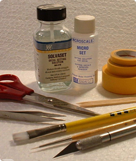
Aérographes
Aéros et coffrets
Accessoires peinture
Adhésifs de finition
Profilés métal-plastique
Socles et vitrines

Documentations
Revues spécialisées
Hors-séries
Documentations techniques
Collections militaires
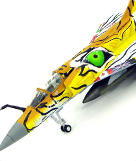
Blindés / Aviation
Ech. 1/72 - 1/48
- Photodécoupes /
- Metal earth - Sonde Voyager

Maquette Metal earth - Sonde Voyager
MKME5061122
Soyez le premier à commenter ce produit

Commandez maintenant pour être livré

Paiement sécurisé

Paypal certifié

Retrait en magasin

Livraison en 24/48h
Prix normal : 14,20 €
Special Price 11,36 €

- Caractéristiques techniques
- Vidéos et autres médias
- L'avis des clients
Donnez votre avis
Vous allez donner votre appréciation du modèle metal earth - sonde voyager . c'est à vous .
Quelle note donneriez-vous à ce produit ? *
- * Titre de votre commentaire
- * Votre commentaire
Venez découvrir notre magasin
200m², 30000 références, une équipe à votre disposition.
Un endroit unique à Paris pour la maquette plastique !
Galerie marchande Gamma
193, rue de Bercy
75012 Paris
01 43 40 47 38

Mon suivi de commande | La livraison | Les moyens de paiement | La newsletter | RSS Nouveautés
Nous contacter | Conditions Générales de Vente | Mentions légales

Voyager 1 & 2
Instruments.
The identical Voyager spacecraft are three-axis stabilized systems that use celestial or gyro referenced attitude control to maintain pointing of the high-gain antennas toward Earth. The prime mission science payload consisted of 10 instruments (11 investigations including radio science).
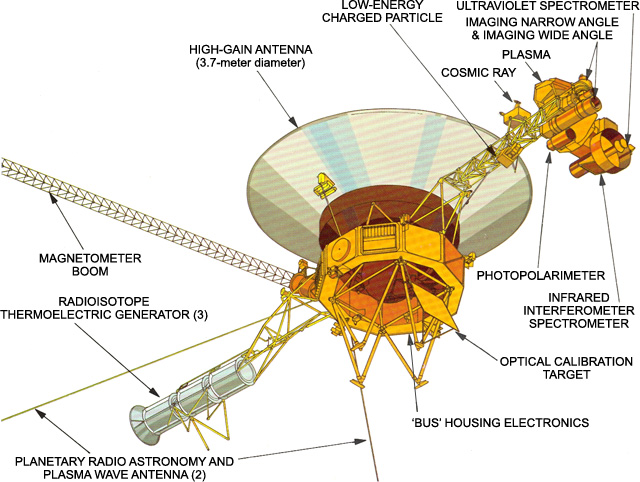
'Bus' Housing Electronics
The basic structure of the spacecraft is called the "bus," which carries the various engineering subsystems and scientific instruments. It is like a large ten-sided box, which can be seen in the Voyager diagram. The centerline of the bus is called the z-axis (and thus the High Gain Antenna) points to Earth. The spacecraft is designed to roll about this axis by firing small thrusters which are attached to the bus.
Each of the ten sides of the bus contains a compartment (a bay) that houses various electronic assemblies. Bay 1, for example, contains the radio transmitters. The bay are numbered 1 to 10 (numbered clockwise as seen from Earth).
Cosmic Ray Subsystem (CRS)
The CRS looks only for very energetic particles in plasma, and has the highest sensitivity of the three particle detectors. Very energetic particles can often be found in the intense radiation fields surrounding some planets (like Jupiter). Particles with the highest-known energies come from other stars. The CRS looks for both.
The CRS makes no attempt to slow or capture the super-energetic particles. They simply pass completely through the CRS. However, in passing through, the particles leave signs that they were there.
Cosmic Ray Subsystem Science Objective
- To measure the energy spectrum of electrons from 3 - 110 MeV.
- To measure the energy spectra and elemental composition of all cosmic ray nuclei from hydrogen through iron over an energy range from approximately 1 - 500MeV/nuc.
- To provide information on the energy content, origin, acceleration process, life history, and dynamics of cosmic rays in the galaxy, and contribute to an understanding of the nucleosynthesis of elements in cosmic ray sources.
- To provide information on the transport of cosmic rays, Jovian electrons, and low energy interplanetary particles over an extended region of interplanetary space.
- To measure the three-dimensional streaming patterns of nuclei from Hydrogen through Iron and electrons over an extended range.
- To measure particle charge compostion in the magnetosphere of Jupiter, Saturn, Uranus, and Neptune.
Principal Investigator
Edward C. Stone California Institute of Technology 289 Cahill Astrophysics
M/S 290-17 Pasadena, CA 91125 [email protected]
High-Gain Antenna
The HGA transmits data to Earth on two frequency channels (the downlink). One, at about 8.4 gigahertz (8,400 million cycles per second), is the X-band channel and contains science and engineering data. For comparison, the FM radio band is centered around 100 megahertz. The X-band downlink science data rates are as high as 7.2 kilobits per second. The other channel, around 2.3 gigahertz, is in the S-band, and contains only engineering data on the health and state of the spacecraft at the low rate of 40 bits per second. S-band has not been used since the last planetary encounter.
Imaging Science Subsystem (ISS)
The ISS is a modified version of the slow scan vidicon camera designs that were used in the earlier Mariner flights. The ISS consists of two television-type cameras, each with 8 filters in a commandable Filter Wheel mounted in front of the vidicons. One has a low resolution 200 mm wide-angle lens with an aperture of f/3, while the other uses a higher resolution 1500 mm narrow-angle f/8.5 lens.
Unlike the other onboard instruments, operation of the cameras is not autonomous, but is controlled by an imaging parameter table residing in one of the spacecraft computers, the Flight Data Subsystem (FDS).
Imaging Science Subsystem Objectives
- Observe and characterize the circulation of the planetary atmosphere, provide limits on atmospheric composition, and determine the wind velocities in the regions observed.
- Map the radial and azimuthal distribution of material in the ring plane; search for new rings.
- Obtain global multi-spectral coverage of all satellites; establish rotation rates and spin axis orientations, study the surface morphology of Triton at spatial resolutions less than 2 km; search for undiscovered satellites.
- Provide support images to assist other onboard investigations in their data reduction.
Infrared Interferometer Spectrometer and Radiometer (IRIS)
The IRIS actually acts as three separate instruments. First, it is a very sophisticated thermometer. It can determine the distribution of heat energy a body is emitting, allowing scientists to determine the temperature of that body or substance. Second, the IRIS is a device that can determine when certain types of elements or compounds are present in an atmosphere or on a surface. Third, it uses a separate radiometer to measure the total amount of sunlight reflected by a body at ultraviolet, visible, and infrared frequencies.
The Infrared Interferometer Spectrometer and Radiometer measures radiation in two regions of the infrared spectrum, from 2.5 to 50μm and from 0.3 to 2.0μm.
Infrared Interferometer Spectrometer and Radiometer Objective
- Determination of atmospheric vertical thermal structure (which in turn aids modeling of atmosphereic dynamics).
- Measurement of the abundances of hydrogen and helium (as a check on theories regarding their ratio in the primitive solar nebula).
- Determination of the balance of energy radiated to that absorbed from the sun (to help investigate planetary origin, evolution, and internal processes).
Low-Energy Charged Particles (LECP)
The LECP looks for particles of higher energy than the PLS, and it overlaps with the Cosmic Ray Subsystem (CRS). It has the broadest energy range of the three sets of particle sensors.
The LECP can be imagined as a piece of wood, with the particles of interest playing the role of bullets. The faster a bullet moves, the deeper it will penetrate the wood. Thus, the depth of penetration measures the speed of the particles. The number of "bullet holes" over time indicates how many particles there are in various places in the solar wind, and at the various outer planets. The orientation of the wood indicates the direction from which the particles came.
The Low-Energy Charged Particle experiment uses two solid-state detector systems mounted on a rotating platform. The two subsystems are the low-energy particle telescope (LEPT) and the low-energy magnetospheric particle analyzer (LEMPA).
Low-Energy Charged Particles (LECP) Objective
- The spectra of the various atomic species comprising the galactic cosmic radiation, especially at low energy.
- Time variation of galactic cosmic rays.
- The radial gradient of galactic cosmic rays.
- Energetic particles of solar origin associated with flares and active regions.
- Energetic particles of planetary origin.
- Interplanetary energetic particles.
Stamatios M. Krimigis Johns Hopkins University Applied Physics Laboratory 11100 John Hopkins Rd. Laurel, MD 20723-6099 [email protected]
Magnetometer (MAG)
Although the MAG can detect some of the effects of the solar wind on the outer planets and moons, its primary job is to measure changes in the Sun's magnetic field with distance and time, to determine if each of the outer planets has a magnetic field, and how the moons and rings of the outer planets interact with those magnetic fields.
Magnetometer (MAG) Objective
- Measure and analytically represent the planetary magnetic fields of Jupiter, Saturn, Uranus, and Neptune.
- Determine the magnetosphere structure of all the giant planets encountered. Investigate the basic physical mechanisms and processes involved both in interactions between the solar wind and the magentosphere and in internal magnetospheric dynamics, in correlative studies with other particles and fields investigations.
- Investigate the interactions of the satellites of these planets with their magnetosphere/solar wind environments.
- Accurately survey the interplanetary magnetic field beyond 1 AU and continue and extend studies of large-scale characteristics of the interplanetary medium.
- Continue and extend studies of the physics of microscale phenomena in the solar wind.
- Search for the transition region between the interplanetary and interstellar media, and if possible, investigate the magnetic characteristics of the boundary region and measure the galactic magnetic field and its variations.
Dr. Adam Szabo NASA Goddard Space Flight Center Code 672 Greenbelt, MD 20771 [email protected]
Optical Calibration Target
The target plate is a flat rectangle of known color and brightness, fixed to the spacecraft so the instruments on the movable scan platform (cameras, infrared instrument, etc.) can point to a predictable target for calibration purposes.
Photopolarimeter Subsystem (PPS)
The Photopolarimeter Subsystem uses a 0.2 m telescope fitted with filters and polarization analyzers. It covers eight wavelengths in the region between 235 nm and 750 nm.
The experiment is designed to determine the physical properties of particulate matter in the atmospheres of Jupiter, Saturn, and the Rings of Saturn by measuring the intensity and linear polarization of scattered sunlight at eight wavelengths in the 2350-7500A region of the spectrum. The experiment will also provide information on the texture and probable composition of the surfaces of the satellites of Jupiter and Saturn and the properties of the sodium cloud around Io. During the planetary encounters a search for optical evidence of electrical discharges (lighting) and auroral activity will also be conducted.
The following two images show the front and side of the PPS instrument.
Planetary Radio Astronomy (PRA)
The Plasma Wave Subsystem and the Planetary Radio Astronomy experiment share the two long antennas which stretch at right-angles to one another, forming a "V". The PWS covers a frequency range of 10 Hz to 56 kHz. The PRA receiver covers two frequency bands, from 20.4 kHz to 1300 kHz and from 2.3 MHz to 40.5 MHz.
Plasma Science (PLS)
The PLS experiment measures the low energy ions and electrons that comprise the bulk of the plasma. Three plasma detectors point in the direction of the Earth to observed solar wind flow and a fourth looks at a right angle to this direction to observed planetary magnetospheres and the heliosphere. It determines the flow speed and direction, density, and temperature of the plasma.
Plasma Science (PLS) Objective
- The properties and radial evolution of the solar wind.
- The interacion of the solar wind with Jupiter, Saturn, Uranus, and Neptune.
- The sources, properties, and morphology of the magnetospheric plasma from Jupiter, Saturn, Uranus, and Neptune.
- The interactions of magnetospheric plasma with the planetary satellites with particular emphasis on plasma properties in the vicinity of Io, Titan, and Triton.
- Ions of interstellar origin.
- Detect and characterize the nature of the termination shock, where the solar wind slows down and becomes more dense as it prepares to encounter the heliopause.
- Make the first detection of the heliopause boundary and the first detection of the plasma from outside our solar system, the interstellar medium.
John Richardson Massachusetts Institute of Technology Center for Space Research 77 Massachusetts Avenue Room 37-641 Cambridge, MA 02139 [email protected]
Plasma Wave Subsystem (PWS)
Donald Gurnett University of Iowa Dept. of Physics & Astronomy Iowa City, IA 52242 [email protected]
Radioisotope Thermoelectric Generators (RTGs)
Three RTG units, electrically parallel-connected, are the central power sources for the mission module. Each RTG is made up of a radioisotope heat source , a thermoelectric converter, a gas pressure venting system, temperature transducers, connectors, a heat rejecting cylindrical container, and bracketry. The RTGs are mounted in tandem (end-to-end) on a deployable boom as part of the MM.
The heat source radioisotopic fuel is Plutonium-238 in the form of the oxide Pu02. In the isotopic decay process, alpha particles are released which bombard the inner surface of the container. The energy released is converted to heat and is the source of heat to the thermoelectric converter.
Ultraviolet Spectrometer (UVS)
The UVS is a very specialized type of light meter that is sensitive to ultraviolet light. It determines when certain atoms or ions are present, or when certain physical processes are going on. The instrument looks for specific colors of ultraviolet light that certain elements and compounds are known to emit.
The Sun emits a large range of colors of light. If sunlight passes through an atmosphere, certain elements and molecules in the atmosphere will absorb very specific frequencies of light. If the UVS, when looking at filtered sunlight, notices the absence of any of these specific colors, then particular elements and/or compounds have been detected. This process is call identifying elements or compounds by atomic absorption.
The Ultraviolet Spectrometer (UVS) covers the wavelength range of 40 nm to 180 nm looking at planetary atmospheres and interplanetary space.
Ultraviolet Spectrometer (UVS) Objective
- To determine the scattering properties of the lower planetary atmospheres.
- To determine the distribution of constituents with height.
- To determine the extent and distribution of hydrogen corona of the planets and satellites.
- To investigate night airglow and auroral activity.
- To determine the UV scattering properties and optical depths of planetary rings.
- To search for emissions from the rings and from any ring "atmosphere."

Everything You Need To Know About Russia: Included Cool Facts About Russia
Traveling in russia – how safe it is , choosing the best guide for a free and memorable moscow tour, e visa russia, how do i exchange money in moscow, eating out in moscow, the best time to travel to russia, moscow subway: the most beautiful subway in the world and how it..., where to stay in moscow, how do i get from moscow airports to the city center, latest travel guide & update.
The core question is it safe to travel to Russia? The answer is absolutely YES! Russia is among the safest places to…
Are you planning to tour Russia in near future? It would be a great decision as the largest country of the world…
Moscow is one of the most vibrant cities that you should explore, at least once in a lifetime. From enthralling architectures to…
E visa Russia An e-visa is a visa which tourists come to Russia with, as well as a visa for business trips,…
You have just arrived in Moscow, maybe even for the first time in Russia and want to get some cash first. It…
Admittedly, when you think of Moscow, the culinary advantages of the Russian capital do not necessarily come to mind first. The largest…
The next vacation destination is certain, it should go to Russia, the giant empire wants to be explored. But when is it…
Moscow subway: the most beautiful subway in the world and how it affects you
Over 2.5 billion passengers a year, 13 lines, 225 stations – the Moscow Metro is Europe’s most used subway network and is…
@2019-2020 - Moscow Voyager. Alexander Popov
We use cookies to provide you with a better experience. By continuing to use our site you accept our cookie policy. Accept Read More

- The Contents
- The Making of
- Where Are They Now
- Frequently Asked Questions
- Q & A with Ed Stone
golden record
Where are they now.
- frequently asked questions
- Q&A with Ed Stone
golden record / whats on the record
Music from earth.
The following music was included on the Voyager record.
- Bach, Brandenburg Concerto No. 2 in F. First Movement, Munich Bach Orchestra, Karl Richter, conductor. 4:40
- Java, court gamelan, "Kinds of Flowers," recorded by Robert Brown. 4:43
- Senegal, percussion, recorded by Charles Duvelle. 2:08
- Zaire, Pygmy girls' initiation song, recorded by Colin Turnbull. 0:56
- Australia, Aborigine songs, "Morning Star" and "Devil Bird," recorded by Sandra LeBrun Holmes. 1:26
- Mexico, "El Cascabel," performed by Lorenzo Barcelata and the Mariachi México. 3:14
- "Johnny B. Goode," written and performed by Chuck Berry. 2:38
- New Guinea, men's house song, recorded by Robert MacLennan. 1:20
- Japan, shakuhachi, "Tsuru No Sugomori" ("Crane's Nest,") performed by Goro Yamaguchi. 4:51
- Bach, "Gavotte en rondeaux" from the Partita No. 3 in E major for Violin, performed by Arthur Grumiaux. 2:55
- Mozart, The Magic Flute, Queen of the Night aria, no. 14. Edda Moser, soprano. Bavarian State Opera, Munich, Wolfgang Sawallisch, conductor. 2:55
- Georgian S.S.R., chorus, "Tchakrulo," collected by Radio Moscow. 2:18
- Peru, panpipes and drum, collected by Casa de la Cultura, Lima. 0:52
- "Melancholy Blues," performed by Louis Armstrong and his Hot Seven. 3:05
- Azerbaijan S.S.R., bagpipes, recorded by Radio Moscow. 2:30
- Stravinsky, Rite of Spring, Sacrificial Dance, Columbia Symphony Orchestra, Igor Stravinsky, conductor. 4:35
- Bach, The Well-Tempered Clavier, Book 2, Prelude and Fugue in C, No.1. Glenn Gould, piano. 4:48
- Beethoven, Fifth Symphony, First Movement, the Philharmonia Orchestra, Otto Klemperer, conductor. 7:20
- Bulgaria, "Izlel je Delyo Hagdutin," sung by Valya Balkanska. 4:59
- Navajo Indians, Night Chant, recorded by Willard Rhodes. 0:57
- Holborne, Paueans, Galliards, Almains and Other Short Aeirs, "The Fairie Round," performed by David Munrow and the Early Music Consort of London. 1:17
- Solomon Islands, panpipes, collected by the Solomon Islands Broadcasting Service. 1:12
- Peru, wedding song, recorded by John Cohen. 0:38
- China, ch'in, "Flowing Streams," performed by Kuan P'ing-hu. 7:37
- India, raga, "Jaat Kahan Ho," sung by Surshri Kesar Bai Kerkar. 3:30
- "Dark Was the Night," written and performed by Blind Willie Johnson. 3:15
- Beethoven, String Quartet No. 13 in B flat, Opus 130, Cavatina, performed by Budapest String Quartet. 6:37

IMAGES
COMMENTS
Maquette plastique sondes spatiales Voyager .Le programme Voyager est un programme d'exploration robotique de l'agence spatiale américaine de la NASA dont l'objectif est d'étudier les planètes extérieures du Système solaire. Il comprend deux sondes spatiales identiques Voyager 1 et Voyager 2 lancées en 1977 qui ont survolé les planètes ...
Two Voyager Space Probes were launched in 1977 to document their "Grand Tour" of our solar system and beyond. The 1,600 pound Voyager payload, built by the Jet Propulsion Laboratory in California, was launched on 5 Sep 77 from Cape Canaveral, Florida atop a Titan-Centaur booster. Voyager, traveling at up to 38,000 miles per hour, completed is ...
Hasegawa model kit in scale 1:48, 54002 is a NEW tool released in 2012 | Contents, Previews, Reviews, History + Marketplace | Unmanned Space Probe VOYAGER | EAN: 4967834540026
5,0 sur 5 étoiles Sonde VOYAGER au 1/48. Commenté en France le 15 juin 2017. Achat vérifié. m Maquette plastique de la sonde Voyager Bon niveau de détails pouvant être amélioré par de la photodécoupe Expérience de maquettiste conseillée Le résultat est détaillé et original.
La maquette de la sonde Voyager est à présent presque terminée, à l'exclusion des 2 antennes radio. Sa Majesté Neptune, dernière planète du Système solaire. faybirdy aime ce message. J'aime 1 Je n'aime pas. 6 Re: Maquette de la sonde Voyager d'Hasegawa au 1/48ème Sam 29 Mai 2021 - 15:57. Apollo68.
RealSpace Models maquette à l'échelle 1:24, est un NOUVEL outil sorti en 200x | Contenu, Aperçus, Avis, Historique + Place de marché | Unmanned Space Probe VOYAGER ... Voyager Échelle: 1:24 Type: Maquette complète Sorti: 200x Nouvel outillage Sujet: Unmanned Space Probe VOYAGER » Espace (Espace) Marquages Satellites Voyager
Ce fascicule très complet permet de tout (ou presque) connaître sur la sonde voyager Historique, technique et schémas permettent en outre de détailler la maquette de la sonde reproduite au 1/48 Fait partie d'une collection très complète sur les véhicules spatiaux et autres...
Overview. The Cover. The Contents. The Making of. Galleries. Videos. Making of the Golden Record. Images on the Golden Record. Galleries of Images Voyager Took.
In the NASA Eyes on the Solar System app, you can see the real spacecraft trajectories of the Voyagers, which are updated every five minutes. Distance and velocities are updated in real-time. For a full 3D, immersive experience click on View Voyagers link below to launch the NASA Eyes on the Solar System app. View Voyager.
- Scientific-MHD
Hasegawa 1/48 Voyager Non Nommé Espace Sonde Maquette en Plastique F/s W/ About this product. About this product. Identifiants du produit. Marque. Hasegawa. Gtin. 4967834540026. Upc. 4967834540026. ... item 2 Eduard Voyager Space Probe, Photo Etch Details, Upgrades 1/48 761 For HASEGAWA Eduard Voyager Space Probe, Photo Etch Details, ...
En 1977, les sondes jumelles quittaient la Terre afin d'explorer le Système solaire extérieur. Elles sont aujourd'hui parmi les objets humains les plus lointains de l'histoire.
1 /9. Lancées en 1977, les deux sondes Voyager ont quitté le système solaire en 2012 et 2018. Les sondes Pioneer 10 et Pioneer 11, lancées en 1972 et 1973, ont elles aussi quitté le système ...
USDZ File (3D Model) (usdz) (1.17 MB) NASA explores the unknown in air and space, innovates for the benefit of humanity, and inspires the world through discovery. A 3D model of NASA's twin Voyager spacecraft.
Achetez votre maquette Metal earth - Sonde Voyager issue des produits pour seulement 11,36 €. Paiement sécurisé, livraison 48h
La sonde Voyager 2.. Le programme Voyager est un programme d'exploration robotique de l'agence spatiale américaine (), dont l'objectif est d'étudier les planètes extérieures du Système solaire.Il comprend deux sondes spatiales identiques, Voyager 1 et Voyager 2, qui sont lancées en 1977 et survolent les planètes Jupiter, Saturne, Uranus et Neptune ainsi que 48 de leurs satellites.
This narrow-angle color image of the Earth, dubbed 'Pale Blue Dot', is a part of the first ever 'portrait' of the solar system taken by Voyager 1. The spacecraft acquired a total of 60 frames for a mosaic of the solar system from a distance of more than 4 billion miles from Earth and about 32 degrees above the ecliptic.
Instruments. The identical Voyager spacecraft are three-axis stabilized systems that use celestial or gyro referenced attitude control to maintain pointing of the high-gain antennas toward Earth. The prime mission science payload consisted of 10 instruments (11 investigations including radio science). Voyager diagram. NASA/JPL-Caltech.
The CCS would be responsible for commands and memory management of the FDS and AACS, which required the addition of a MEMLOAD routine (to load memory, as implied) and an AACSIN routine for health monitoring of the AACS. Each computer system on the Voyager spacecraft was dual-redundant— there were two CCS', two FDS', and two AACS'.
Moscow subway: the most beautiful subway in the world and how it affects you. Over 2.5 billion passengers a year, 13 lines, 225 stations - the Moscow Metro is Europe's most used subway network and is…. 1. 2. 3. Russia travel advice.
Alan ultimately suggested fifteen of the twenty-seven performances that were launched with the probes on what are now popularly known as the "Voyager golden records.". While their initial objective was to explore Jupiter and Saturn, Voyagers 2 (launched August 20, 1977) and Voyager 1 (launched September 5, 1977) have traveled farther from ...
The following music was included on the Voyager record. Bach, Brandenburg Concerto No. 2 in F. First Movement, Munich Bach Orchestra, Karl Richter, conductor. 4:40; Java, court gamelan, "Kinds of Flowers," recorded by Robert Brown. 4:43; Senegal, percussion, recorded by Charles Duvelle. 2:08
Moskva, formerly Slava, was a guided missile cruiser of the Russian Navy.Commissioned in 1983, she was the lead ship of the Project 1164 Atlant class, named after the city of Moscow.With a crew of 510, Moskva was the flagship of the Black Sea Fleet and the most powerful warship in the region. The cruiser was deployed during conflicts in Georgia (2008), Crimea (2014), and Syria (2015).